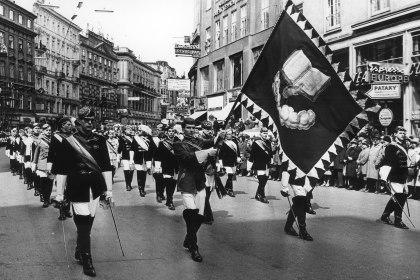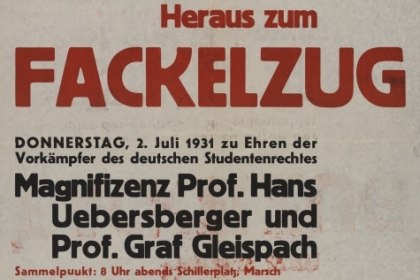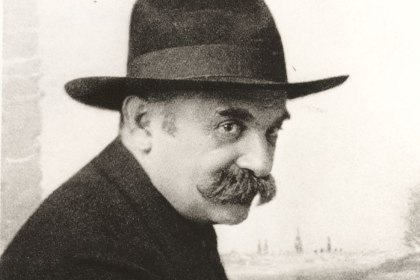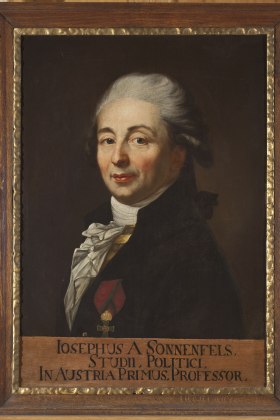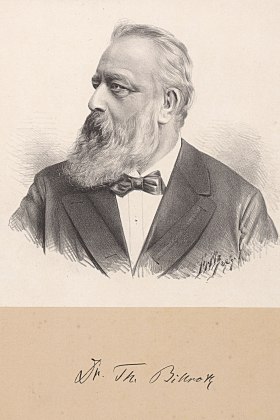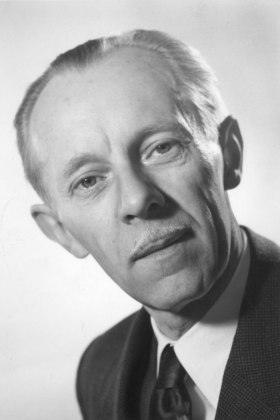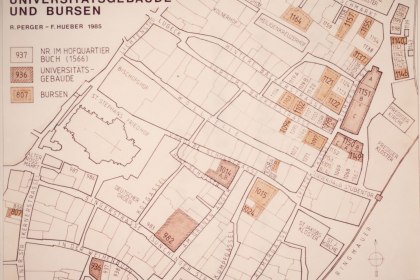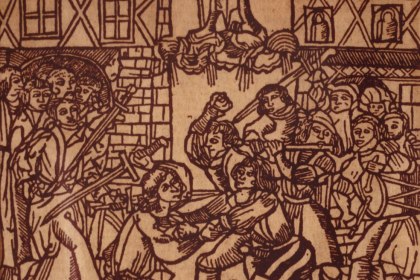Anti-Semitism at the University of Vienna
Anti-Semitism and German Nationalism were already rampant among members of the University of Vienna before National Socialism came to power in Austria in March 1938.
The early history of academic anti-Semitism at the University of Vienna was marked by the so-called “Vienna Gesera”, the systematic destruction of the Jewish communities in the duchy of Austria in 1421. Duke Albert V had Jews arrested in 1420 and over the course of a few months drove them out of Austria under accusations of collaboration with Hussites, stories of ritual murder and host desecration. All Jews left in Vienna – more than 200 – were sentenced to death on March 12, 1421, and brutally executed by burning on the same day at the Gänseweide in Erdberg. The University of Vienna profited from the pogrom in 1420/21: the stones from the destroyed synagogue were used to build a new faculty building (Nova Structura). Today, a memorial plaque in Erdberg (Kegelgasse 40) commemorates the Vienna Gesera.
In the middle of the 16th century, Antonius Margaritha (from 1533 until his death in 1542) and later Paulus Weidner (ca. 1560-1585) – both having converted from Judaism to Catholicism – were the first to teach Hebrew at the University of Vienna. They also acted as political advisors to the monarchy in regard to anti-Jewish measures. Weidner furthermore gained influence at court as personal physician to the Emperor and at the university as dean and rector.
Under Emperor Leopold I, another wave of reprisals against the Viennese Jews took place, which ended with their expulsion in 1670. Vienna University students were substantially involved in anti-Jewish riots.
The Patent of Toleration issued by Emperor Joseph II in 1782 improved Austrian Jews’ legal status and laid the foundation for the admission of Jewish students to the “worldly” faculties of the University of Vienna. Joseph von Sonnenfels, an ennobled Jewish convert, influenced the legislation of Joseph II in general and studies at the University of Vienna in particular as a lawyer, as professor of police science and Cameralism (political science) and as rector of the University of Vienna.
After the revolution of 1848/49, Jews received equal status as citizens and recognition as a religious community with the Staatsgrundgesetz (basic law) of 1867. The revolution, however, also established the basis for the foundation of numerous fraternities and other students associations , many of which drifted towards German National and anti-Semitic ideologies over the course of the 19th century, leading to a lasting politicization at the University of Vienna. Many prominent professors – among them the famous surgeon Theodor Billroth – publically stepped out with anti-Semitic remarks.
In the first decades of the 20th century German National and Catholic National teachers increasingly organized themselves against their Jewish competition and oftentimes prevented them from receiving positions at the university. The “Deutscher Klub” (“German Club”) and the „Bärenhöhle“, (“Bear’s Den”) are examples of these organizations, which were particularly active in the interwar period as anti-Semitic networks within the university. Since the 1920s violent attacks by German National and National Socialist students against Jewish and socialist classmates increased, particularly at the Institute of Anatomy under Julius Tandler, or on the occasion of the abolishment of the anti-Semitic Gleispach student regulation 1930.
When Austrofascism came into power, anti-Semitism was still commonplace at the University of Vienna. This manifested itself in several riots by National Socialist students, but in particular also in the public discussion about the murder of philosopher Moritz Schlick in the university’s Main Building in 1936.
Finally, in 1938, the anti-Semitic tendencies culminated in the complete and systematic expulsion of Jewish teachers and students from the University of Vienna after Austria’s “Anschluss” to the National Socialist German Reich. More than 2500 university members classified as “Jewish” were removed from the university and were subsequently subject to further persecution up to the extermination in the system of concentration camps.
Anti-Semitism after 1945
After the end of the Second World War, “reconstruction” overcast the issue of dealing with the university’s involvement in National Socialism. Due to efforts to swiftly resume normal operations at the University of Vienna, denazification of teachers and students was not conducted very consequently. In contrast, expelled Jewish scientists who had fled abroad were often not reintegrated. Slowly even exposed National Socialists were allowed to return to their former positions at the university, which became very clear two decades later in the scandal surrounding the open anti-Semitism of Taras Borodajkewycz, a professor of economic history at the Vienna University of Economics and lecturer at the University of Vienna. The death of Ernst Kirchweger, a former communist resistance fighter, received international attention when he was assaulted by a neo-Nazi during a large demonstration against Borodajkewycz and died several days later as a result of his injuries.
In the 1980s a discourse about its role in National Socialism and anti-Semitism developed at the University of Vienna. Apart from numerous research projects, the university’s new reflected approach towards its involvement was for example expressed in the historical and artistic contextualization of the German National “Siegfriedskopf” monument in the University Main Building in 2006. Despite various studies many questions remain unanswered in this context. These include contemporary historical aspects that for example concern anti-Semitic structures and networks at the university before 1938, or the Catholic-theological faculty’s involvement in the Gesera in 1420/21, which is currently being investigated in a research project at the faculty.
-
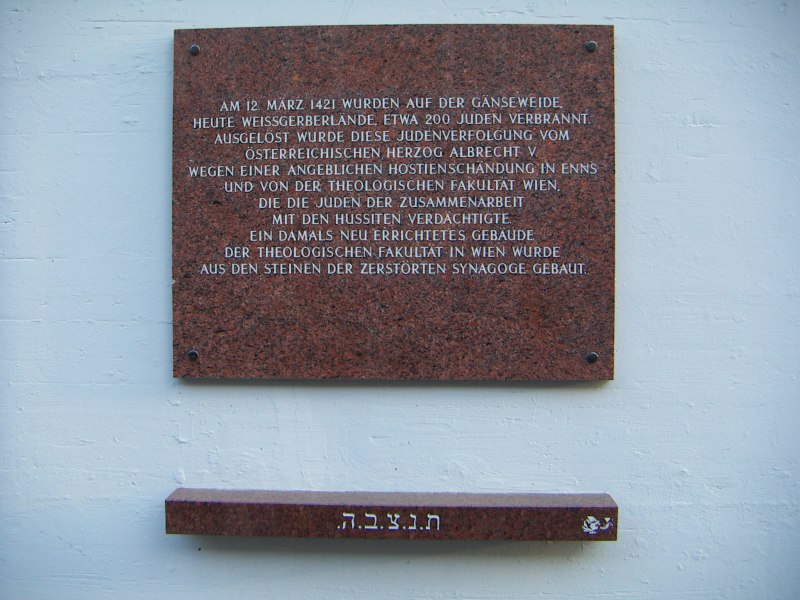
Gedenktafel für Opfer der Wiener Geserah am 12. März 1421
Tatsächlich handelt es sich bei dem auf der Gedenktafel erwähnten Gebäude um die Nova structura (Neue Schule), welche unter der Bauführung der...
Zuletzt aktualisiert am 11/08/24
-
“Furor teutonicus and racial hate”
1867–1893 -
Student corporations in the 19th and 20th century
19th Cent.–20th Cent. -
The “Bärenhöhle” – a secret anti-Semitic group of professors in the inter-war period
1918–1965 -
The Gleispach’sche Studentenordnung (Gleispach Student Regulation)
1930–1931 -
Terror against the Anatomical Institute of Julius Tandler
1920–1934 -
Expulsion of teachers and students in 1938
1938 -
The de-Nazification of the professorate at the University of Vienna
1945–1950
-
Paulus Weidner von Billerburg
1525–28.8.1585 -
Josef von Sonnenfels
1733–25.4.1817 -
Joseph II. von Österreich (Habsburg-Lothringen)
13.3.1741–20.2.1790 -
Theodor Billroth
26.4.1829–6.2.1894 -
Moritz Schlick
14.4.1882–22.6.1936 -
Taras Borodajkewycz
1.10.1902–10.1.1984 -
Anton Edler von Rosas
23.12.1791–31.5.1855



